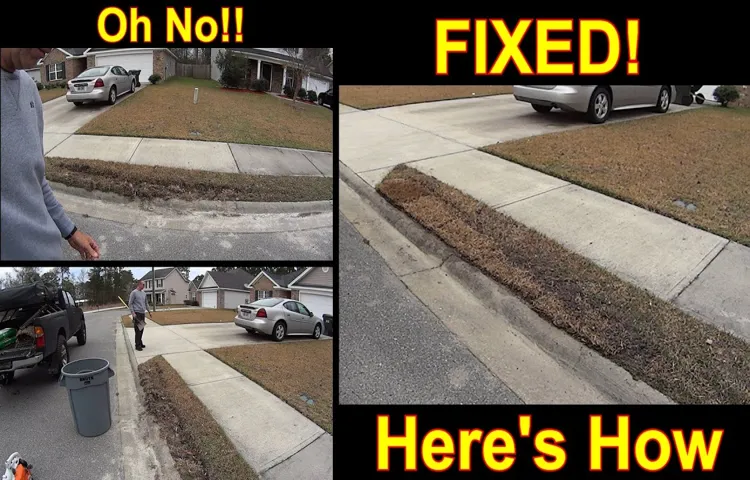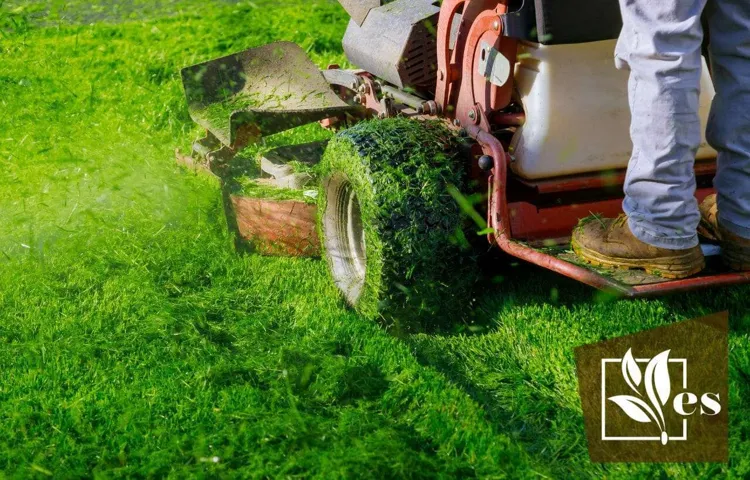Have you ever looked out onto your beautiful lawn, only to find tire tracks interrupting the lush greenery? It can be frustrating and worrisome when the damage left behind from a vehicle seems irreversible. However, fear not, as fixing tire tracks on your lawn can be easier than you think. In this article, we’ll provide you with step-by-step instructions on how to restore your lawn to its previous condition, so you can once again enjoy the scenery without the eyesore of tire marks.
With a little bit of time and effort, your lawn will be looking as good as new.
Table of Contents
Identify the Problematic Areas
When trying to fix tire tracks on your lawn, the first step is to identify the problematic areas. Walk around and inspect your lawn to pinpoint exactly where the damage has occurred. Look for areas where the grass appears flattened or has been torn up, and note their location.
Once you’ve identified these areas, you can start to take action to repair them. One essential thing to keep in mind is to avoid driving over the affected areas until you’ve fixed them. This will prevent further damage and significantly improve the effectiveness of your repairs.
So take the time to inspect your lawn thoroughly and then move on to the next steps to remedy the situation. With a little effort and careful attention, you can have your lawn back to its full glory in no time!
Inspect the Lawn
When inspecting your lawn, it’s important to identify the problematic areas so you can take the necessary steps to fix them. Start by looking for areas with thinning or dead grass. This could be caused by a lack of water, poor soil quality, or pests.
Additionally, keep an eye out for any weeds or patches of different types of grass that don’t match the rest of your lawn. These could be indicators of an underlying issue, such as a fungal disease or improper fertilization. By identifying these problematic areas, you can develop a plan of action to restore your lawn to its full potential.
Don’t ignore these issues and hope they go away on their own, as they will only worsen over time. Instead, address the problem head-on and take the necessary steps to keep your lawn looking healthy and vibrant. With a little time and effort, you can transform your lawn into the envy of the neighborhood.

Mark the Locations with Flags or Stakes
Identifying the problematic areas in your yard is essential to maintaining a healthy and flourishing landscape. A great way to do this is by marking these areas with flags or stakes. This will make it easier to remember where these issues are, as well as make it clearer to anyone else who may be working on your yard.
You can use different colored flags or stakes to represent different issues such as areas that need fertilization, areas with pests, or areas with drainage issues. This not only helps with maintaining your yard but also allows you to prioritize which issues need to be tackled first. By using flags or stakes to mark these problematic areas, you can effectively keep track of what needs to be done and accomplish it quickly and efficiently.
Rake and Level the Affected Areas
If you have tire tracks on your lawn, don’t worry – it’s not the end of the world! One of the first steps you can take is to grab a rake and start leveling out the affected areas. Depending on the extent of the damage, you may need to remove any debris or clumps of soil before you start. Once you’ve cleared the area, use the rake to smooth and level out the ground.
This will help ensure that the area is even and ready for seeding or sodding. It’s essential to take your time and make sure you get rid of any remaining tire tracks or bumps. If you don’t, it could make mowing or other lawn care activities more challenging in the future.
Once you’ve done this step, you can move on to other aspects of repairing your lawn, such as adding new grass seed or sod. Overall, leveling out the damaged areas with a rake is one of the first and most crucial steps in fixing tire tracks on your lawn.
Use a Metal Rake to Even the Surface
When you have rough areas in your lawn, it’s essential to rake and level them to create an even surface. A metal rake is a perfect tool for the job as it has sharp teeth that can dig into the soil. Start by raking the affected areas to remove any debris, rocks, or dead grass.
Push the rake back and forth in both directions to break up any compacted soil. The prongs of the rake will also help to aerate the soil and create thousands of tiny holes that will allow air, water, and nutrients to penetrate deeper into the ground. After raking, level the area by raking over it again, but this time, make sure to rake in only one direction.
This will create a smooth and level surface that will be ready for seeding or adding new sod. Remember, using a metal rake might be a bit tough on your back, so it might be best to use a support belt to avoid straining your muscles. So gear up, grab your metal rake, and get ready to transform your lawn!
Add Soil to the Low Spots
If you notice low spots in your lawn, it’s important to take action to prevent water from pooling. One way to address this issue is by adding soil to the affected areas. First, rake the area to remove any debris or dead grass.
Next, level the spot by spreading a layer of soil over it. Be sure to choose a high-quality soil that will provide the necessary nutrients for the grass. Use a garden rake or shovel to spread the soil evenly over the low spot.
You may need to repeat this process over time, as the soil settles and compacts. Adding soil to the low spots in your lawn is a simple yet effective way to keep your lawn healthy and prevent water damage. By doing so, you’ll save yourself from costly repairs down the line, and your lawn will have a smooth, even surface for years to come.
Water the Affected Areas
Raking and leveling the affected areas of your lawn is crucial in maintaining its lush appearance. Start by removing any debris or dead grass with a rake or garden fork. Next, use a leveling tool like a lawn roller or a drag mat to smooth out any bumps or uneven spots.
Keep in mind that a sandy soil type may require more leveling than a clay soil. After raking and leveling, water the affected areas thoroughly to promote growth and encourage the soil to settle. This step is especially important in areas that are prone to drought or have not received consistent watering.
By regularly raking, leveling, and watering your lawn, you can keep it looking healthy and vibrant all year round.
Replant Grass Seed
If you’ve accidentally had a tire track on your lawn, don’t worry, it’s not the end of the world. Fixing tire tracks on your lawn is easy, and you can do it yourself without any professional assistance. One of the best ways to do it is by replanting grass seed.
Firstly, remove any debris or dirt in the tire tracks with a rake. Once the soil is prepared, you can apply the grass seed evenly in the affected area. It’s essential to ensure that the soil is moist before and after planting the grass seed to boost germination.
It’s also essential to ensure that the grass seed you choose is suitable for your lawn type, climate, and the amount of sunlight your lawn receives. Then, cover the seeds with a layer of paper or straw to help retain moisture in the soil. With attentive watering, your lawn will recover and look as good as new, and you’ll have a lush green lawn to show off in no time!
Choose the Right Seed
When it comes to replanting your lawn, choosing the right seed is key. You’ll want to select a grass species that is well-suited to your climate and soil type. Consider factors like the amount of sun or shade in your yard, as well as foot traffic and water availability.
Additionally, you’ll want to look for high-quality seed that is free from weeds and other contaminants. Don’t be afraid to do your research and read product labels to ensure you’re getting the best possible seed for your yard. With the right seed and proper care, you can enjoy a lush, healthy lawn in no time!
Spread the Seed Evenly Across the Affected Areas
Replanting grass seed can be an effective way to rejuvenate those patchy areas of your lawn. However, it’s important to ensure that the seed is spread evenly across the areas that need it. This will not only increase the chances of successful germination, but it will also lead to a more uniform and attractive lawn.
When spreading the seed, make sure to use a spreader or rake and aim for a consistent application. Also, be sure to choose the right type of seed for your lawn, depending on factors such as climate, soil type, and sunlight exposure. Once the seed has been spread, keep the area well-watered and avoid walking on it until the grass has had a chance to grow strong roots.
With a little patience and TLC, you’ll soon have a lush, green, and healthy lawn again. So why not take the first step today and start replanting that grass seed? Your lawn will thank you!
Prevention Tips
If you have tire tracks on your lawn, don’t worry. There are a few things you can do to fix them and prevent them from happening again in the future. Firstly, when mowing your lawn, make sure to avoid driving the lawnmower over the same area repeatedly.
Doing so can cause tire tracks to form, which can be difficult to get rid of. Secondly, don’t park heavy vehicles on your lawn, especially if the ground is wet. The weight can sink into the soil and create undesirable indentations.
If you do need to park a vehicle on your lawn, consider placing a piece of plywood or other solid board under the tires to distribute the weight more evenly. Finally, consider aerating and regularly fertilizing your lawn to keep the soil healthy and minimize the appearance of tire tracks. If you already have tire tracks on your lawn, you can use a steel garden rake to smooth out the affected areas.
Alternatively, you can fill the tracks with soil and level it off. With these tips, you can keep your lawn looking healthy and vibrant all year round.
Avoid Driving on the Lawn
Driving on the lawn may lead to some unintended consequences, such as damaging your grass, creating ruts, or causing erosion. To avoid these problems, there are several prevention tips that you can follow. First of all, if you need to access your lawn with a vehicle, consider building a gravel or stone path that can withstand the weight of your car.
This way, you won’t risk damaging your grass or creating tire marks. Additionally, you can install a fence that separates your car parking area from your lawn, making it clear where you should and shouldn’t drive. Finally, try to limit the amount of traffic on your lawn as much as possible, and encourage your family and visitors to park on the driveway or street instead.
By following these tips, you can preserve the health and beauty of your lawn while still allowing for easy access to your home or garage.
Create a Permanent Pathway
Creating a permanent pathway for prevention is one of the most effective ways to combat future problems. It is important to identify the root of the issue to properly address it. For example, if a company is experiencing frequent data breaches, it may be necessary to invest in better cybersecurity measures.
Additionally, training employees on proper security protocols can also help prevent future breaches. Taking proactive steps to address an issue before it occurs can save time, money, and resources in the long run. By creating a reliable and permanent pathway for prevention, companies can ensure that they are always prepared for any potential problems that may arise.
It’s important to constantly evaluate and update prevention strategies to ensure they are up-to-date and effective. By doing so, companies can stay ahead of the curve and prevent problems before they even occur.
Regularly Aerate the Lawn
Proper lawn aeration is essential for maintaining a healthy and well-manicured lawn. Lawn aerators create small holes in the soil, which allow air, water, and nutrients to penetrate deep into the roots of the grass. This results in a stronger and more resilient lawn that can better withstand harsh weather conditions and heavy foot traffic.
When planning to aerate your lawn, there are a few essential tips to keep in mind. Firstly, you should aim to aerate at least once a year, depending on the current condition of your lawn. Secondly, make sure to water your lawn thoroughly a day or two before aerating to ensure the soil is moist and easy to penetrate.
Lastly, avoid over-aerating your lawn, as this can cause damage to the roots and leave your lawn vulnerable to pests and disease. Keep in mind that regular lawn aeration is a small investment that can pay off significantly in the long run, leading to a luscious lawn that’s the envy of the whole neighborhood.
Consider Adding Stepping Stones
Adding stepping stones to your garden or outdoor space not only adds an aesthetic touch, but it can also prevent accidents and injuries. Stepping stones create a clear pathway for individuals to follow, guiding them through your garden while preventing them from accidentally stepping on delicate plants or uneven terrain. Furthermore, if you live in a region with rainy or snowy weather, adding stepping stones can prevent slips and falls as they provide a stable surface to walk on.
By strategically placing stepping stones, you can create a safe and inviting environment for guests to enjoy. Plus, there are many varieties and designs to choose from, allowing you to add a personalized touch to your outdoor space. Overall, adding stepping stones is an easy and effective way to enhance safety and beautify your garden.
Conclusion
In conclusion, fixing tire tracks on your lawn is as easy as 1-2-3! First, get some topsoil and spread it over the affected area. Then, use a lawn roller to level it out. Finally, add some grass seed and water it regularly to ensure proper growth.
Voila! Your lawn will look as good as new. Remember, a little bit of TLC goes a long way in keeping your lawn looking pristine. So give your lawn some love and it’ll reward you with lush, green goodness!”
FAQs
What causes tire tracks on the lawn?
Tire tracks on the lawn are often caused by heavy equipment or vehicles driving over it, especially when the ground is wet.
How do I prevent tire tracks on my lawn?
You can prevent tire tracks on your lawn by avoiding heavy equipment or vehicles on it, and placing a barrier or fence around the lawn to limit access.
How do I fix tire tracks on my lawn?
One way to fix tire tracks on the lawn is to loosen the soil with a garden fork or aerator, then add new soil and grass seed to the area. Another option is to use a lawn roller to even out the surface, before reseeding the area.
What type of soil should I use to repair tire tracks on my lawn?
It’s best to use a high-quality topsoil for repairing tire tracks on the lawn, as it will contain the necessary nutrients and organic matter needed for healthy grass growth.
Can tire tracks on the lawn damage the grass permanently?
If left untreated, tire tracks on the lawn can damage the grass permanently, as they can compact the soil and limit grass growth. However, with proper repair and maintenance, the grass can recover.
How often should I repair tire tracks on my lawn?
It’s best to repair tire tracks on the lawn as soon as possible after they occur, to prevent permanent damage to the grass. Regular lawn maintenance can also help prevent future tire tracks.
Should I avoid using heavy equipment on my lawn altogether?
It’s not necessary to avoid heavy equipment on the lawn altogether, but it’s important to be mindful of the impact it can have on the grass. If possible, limit heavy equipment use and use alternative areas for parking or storage.



